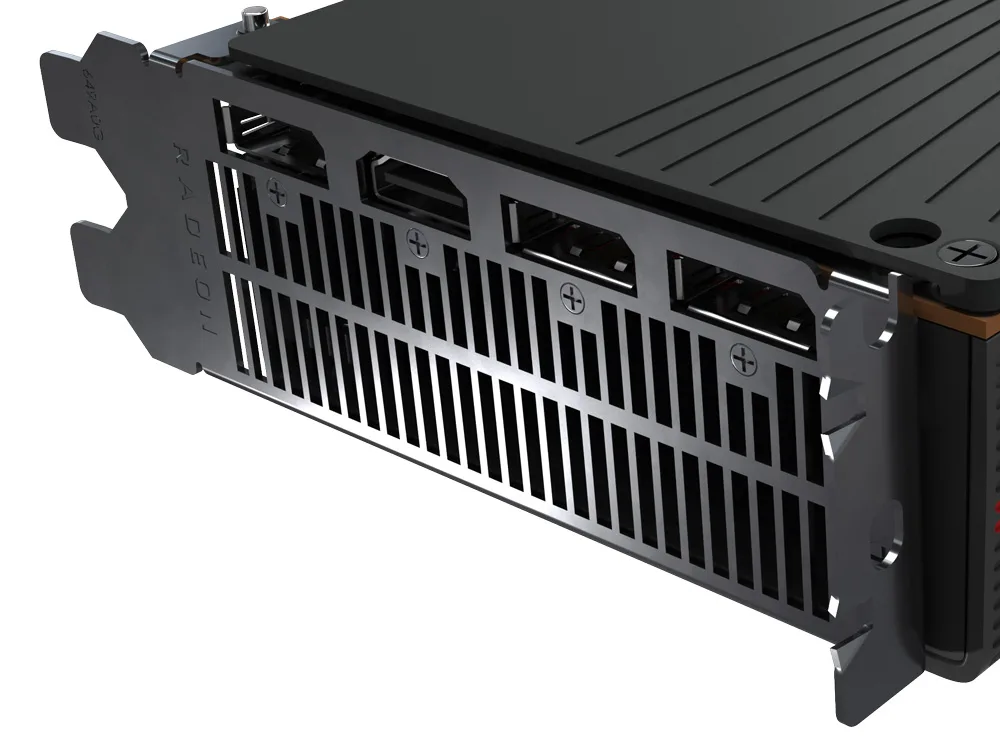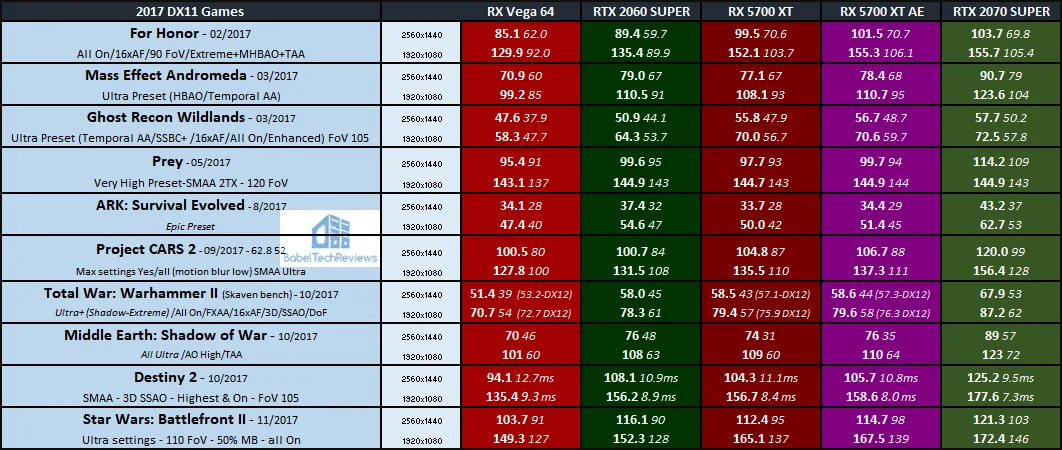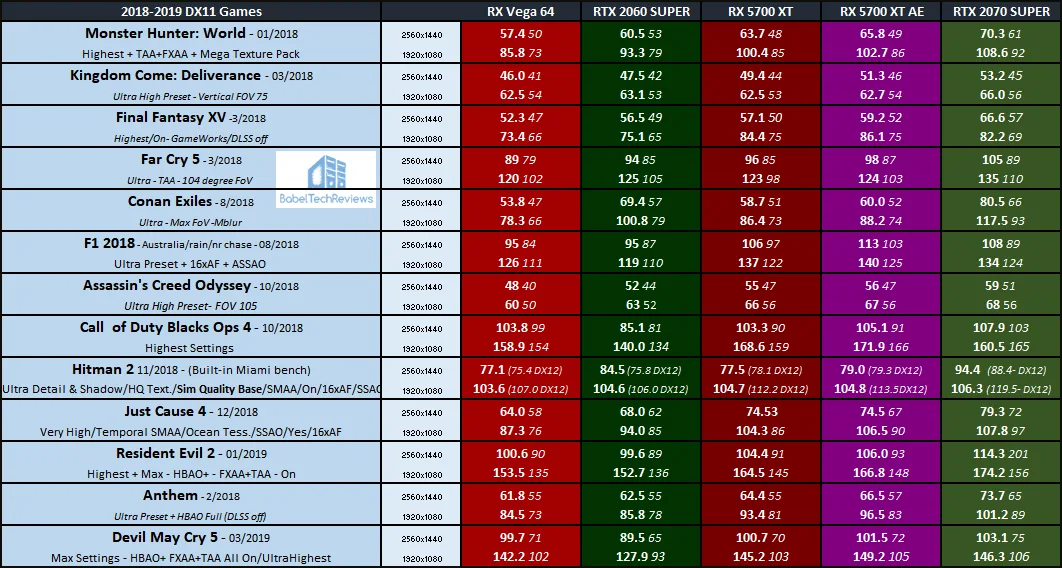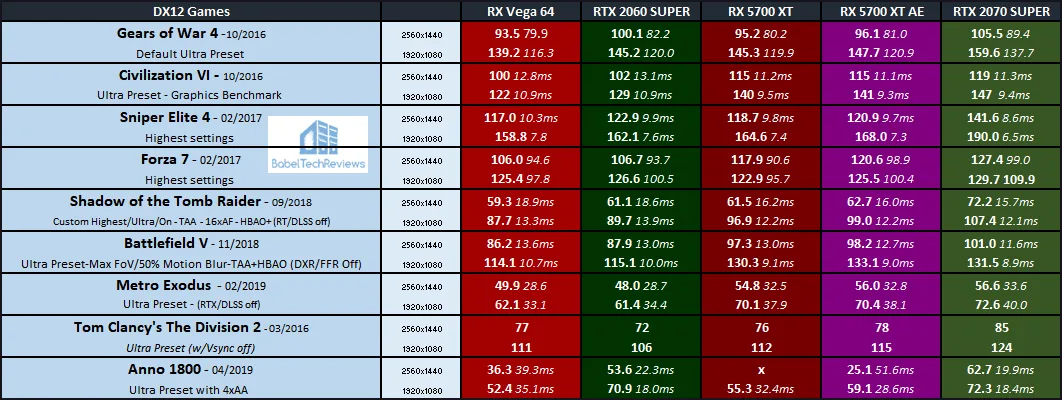The RX 5700 XT Anniversary Edition vs. the liquid cooled RX Vega 64 and vs. NVIDIA’s RTX 2060 and RTX 2070 SUPER Cards
BTR purchased a $449 RTX 5700 XT Anniversary Edition directly from AMD.com on its launch day. After three days evaluating it and comparing with ten other competing cards by benching it with 40 games, here is our review. Our focus is on its performance compared with the premium liquid-cooled RX Vega 64 as well as versus the RTX 2070 SUPER and RTX 2060 SUPER. 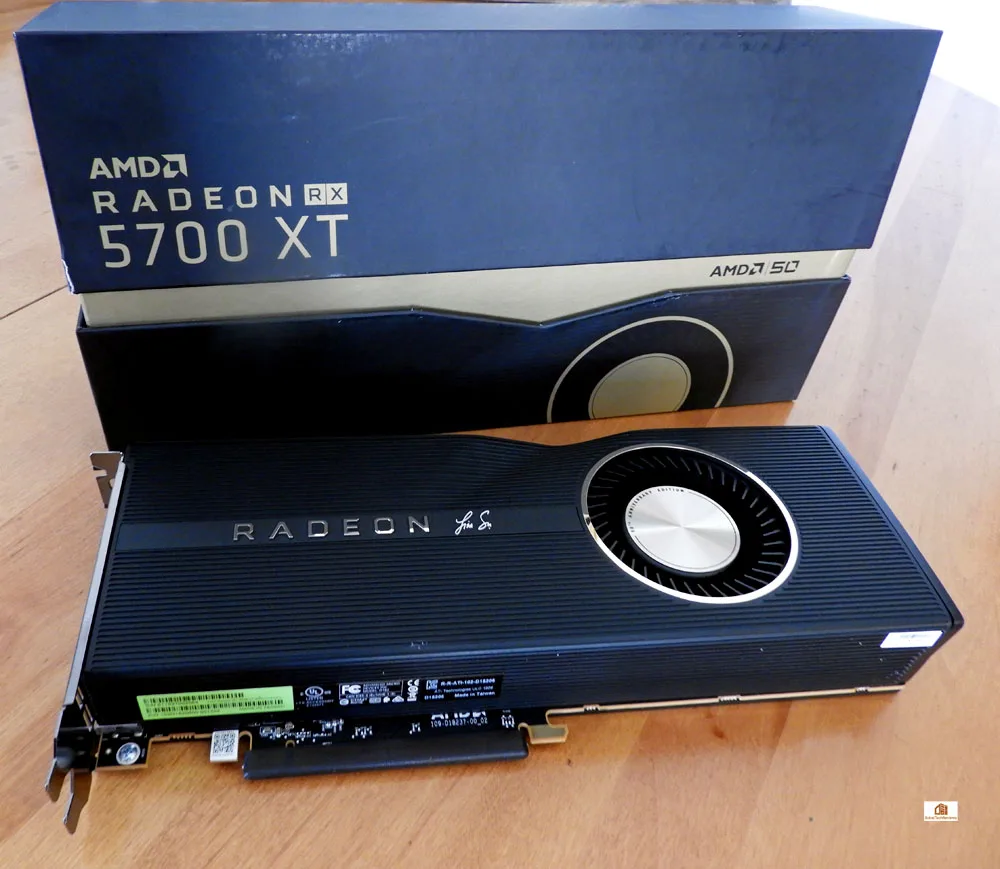
Arriving on 7nm, the RX 5700 series signal AMD’s return to competitiveness, and its new RDNA architecture is also the largest change since GCN. At $449, AMD’s 50th Anniversary Edition is AMD’s reference Navi flagship that boasts a 75MHz factory overclock over the reference XT and it features a special gold-trimmed shroud with CEO Dr. Lisa Su’s signature.
Besides the Anniversary Edition, there are two blower-style reference Radeon RX 5700 Series GPUs, the $349 RX 5700 and the $399 RX 5700 XT. We are going to feature the fastest card of the series today. 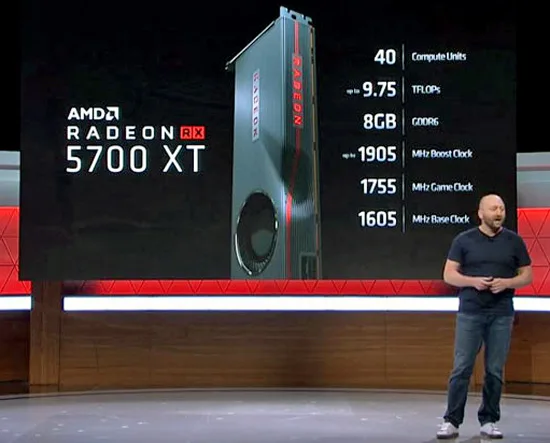 All RX 5700 cards feature redesigned Compute Units delivering up to 1.25X higher performance-per-clock and up to 1.5X higher performance-per-watt over the last generation. The RDNA architectural improvements include a new instruction set better suited for rendering graphics effects effects more quickly, and multi-level cache hierarchy for reduced latency with more responsive gaming.
All RX 5700 cards feature redesigned Compute Units delivering up to 1.25X higher performance-per-clock and up to 1.5X higher performance-per-watt over the last generation. The RDNA architectural improvements include a new instruction set better suited for rendering graphics effects effects more quickly, and multi-level cache hierarchy for reduced latency with more responsive gaming.
Other features include:
- Radeon Image Sharpening (RIS) – Restores clarity to in-game images that have been softened by other post-process effects like with TAA.
- FidelityFX – An open-source developer toolkit to makes it easier for developers to create high-quality post-processing effects with a good balance of visuals and performance.
- FidelityFX features Contrast-Adaptive Sharpening (CAS) to improve detail in low-contrast areas while minimizing artifacts.
- Radeon Anti-Lag – Optimized for eSports to decrease input-to-display response times.
- Extreme refresh rates – RDNA enables DisplayPort 1.4 with Display Stream Compression (DSC) for super high refresh rate displays.
The RX 5700 XT Anniversary Edition
The RX 5700 XT Anniversary Edition arrives well-protected in its box. There are no accessories but it comes with a 3-year warranty and some documentation.
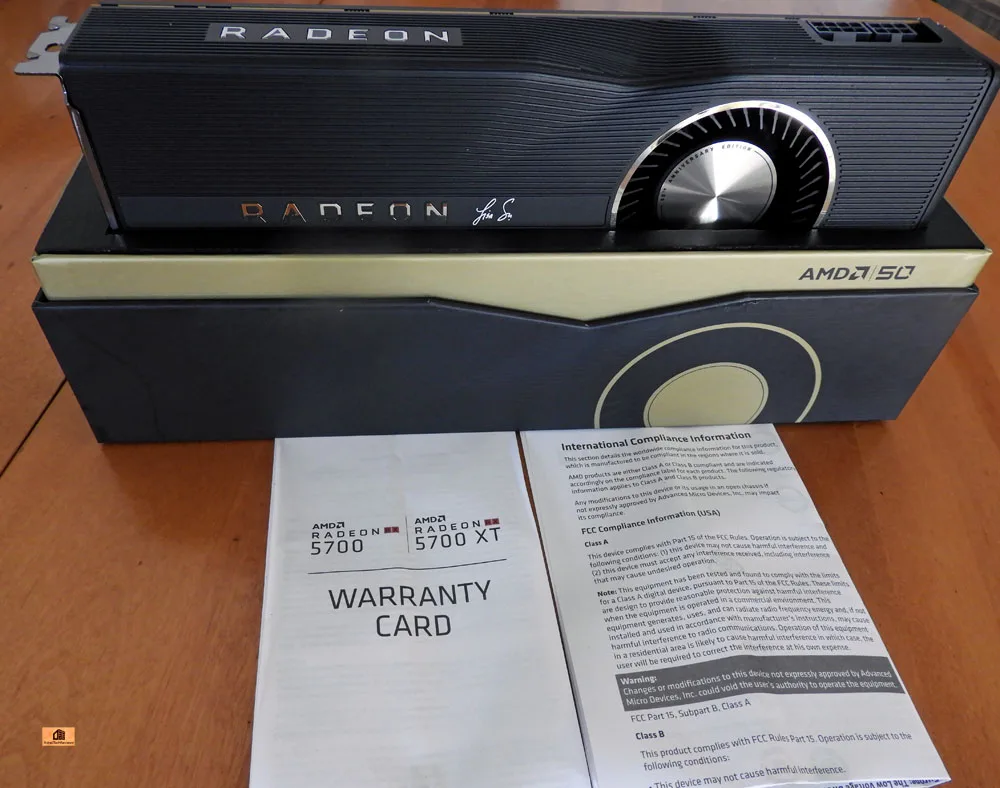
It uses a standard blower which is great for small cases but gets a bit loud under load if the fan profile is adjusted for performance. The indentation in the shroud is for improved cooling but we wish that AMD had offered a liquid-cooled AIO or dual-fan option on launch day.
The RX 5700 XT uses typically 235W board power drawing power from the PCIe slot and the 6-pin and 8-pin PCIe connectors. A 600W or better power supply is a good idea especially if you are overclocking.
The backplate is solid and has a clean look.
There are 3 DisplayPorts and 1 HDMI port. Currently, all of the reference RX 5700 cards are blower models.
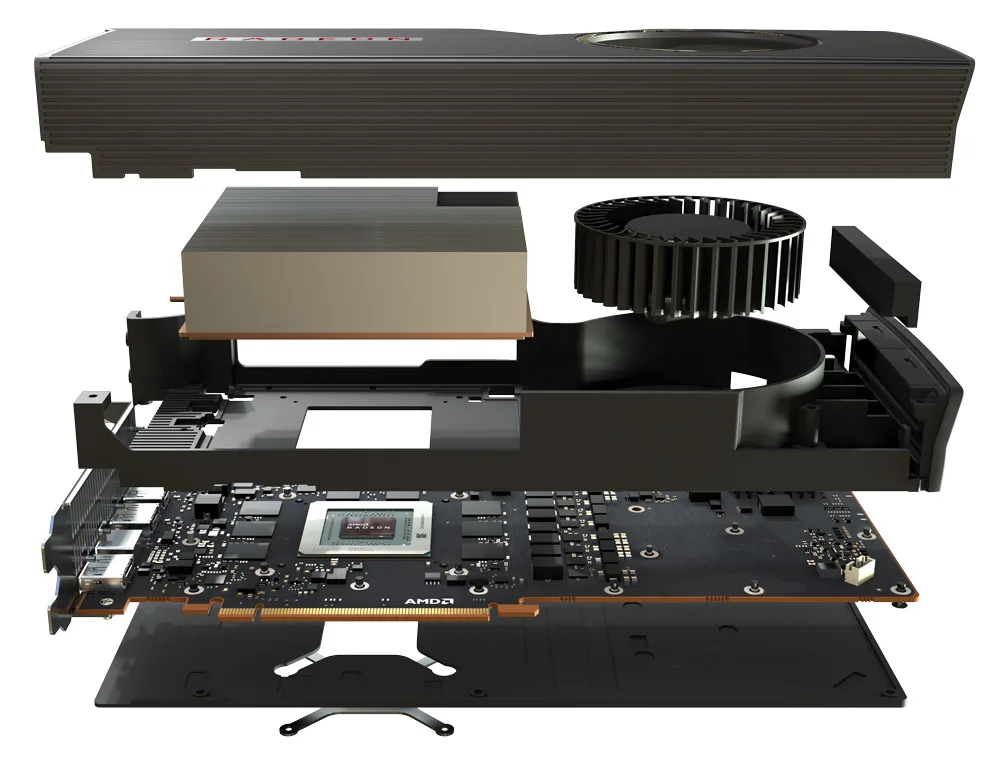
There will be partner versions available perhaps starting next month that will offer more and better cooling choices along with overclocked versions.
Our Testbed with Ten Competing Cards
We test 40 games and 3 synthetic benchmarks at 1920×1080 and at 2560×1440. In addition, Hitman 2 and Total War: Warhammer II are benchmarked on DX11 and on DX12. Our latest game is Anno 1800.
- RX 5700XT Anniversary Edition 8GB
- RX Vega 64 liquid cooled Edition 8GB
- Red Devil RX Vega 56 8GB
- Red Devil RX 590 8GB
- RTX 2070 SUPER Founders Edition 8GB
- RTX 2060 SUPER Founders Edition 8GB
- RTX 2060 Founders Edition 8GB
- RTX 2070 Founders Edition 8GB
- RTX 2080 Founders Edition 8GB
- GTX 1080 Ti Founders Edition 11GB
- EVGA GTX 1060 SC 6GB
Our testing platform is a recent install of Windows 10 64-bit Home Edition v1903, and we are using an i7-8700K which turbos all 6 cores to 4.8GHz, an EVGA Z370 FTW motherboard, and 16GB of XTREEM DDR4 at 3866MHz. The games, settings, and hardware are identical except for the cards being compared.
How does the RX 5700XT Anniversary Edition 8GB compare with other competing cards?
NVIDIA recently launched the RTX 2070 SUPER at $499 and the RTX 2060 SUPER at $399 with upgraded performance and a game bundle, so we want to see where the $449 RX 5700 XT Anniversary Edition fits in. We have downclocked our card by 75MHz to simulate the performance of the $399 reference RX 5700 XT and have included its benchmarks.
Test Configuration – Hardware
- Intel Core i7-8700K (HyperThreading and Turbo boost are on to 4.8GHz for all cores; Coffee Lake DX11 CPU graphics).
- EVGA Z370 FTW motherboard (Intel Z370 chipset, latest BIOS, PCIe 3.0/3.1 specification, CrossFire/SLI 8x+8x), supplied by EVGA
- T-FORCE XTREEM 16GB DDR4 (2x8GB, dual channel at 3866MHz), supplied by Team Group
- RX 5700XT Anniversary Edition 8GB at Anniversary Edition and reference XT clocks
- RX Vega 64 liquid cooled Edition 8GB
- Red Devil RX Vega 56 8GB, on loan from PowerColor
- Red Devil RX 590 8GB on loan from PowerColor
- RTX 2070 SUPER Founders Edition 8GB, on loan from NVIDIA
- RTX 2060 SUPER Founders Edition 8GB, on loan from NVIDIA
- RTX 2060 Founders Edition 8GB, on loan from NVIDIA
- RTX 2070 Founders Edition 8GB, on loan from NVIDIA
- RTX 2080 Founders Edition 8GB, on loan from NVIDIA
- GTX 1080 Ti Founders Edition 11GB, on loan from NVIDIA
- EVGA GTX 1060 SC 6GB on loan from EVGA
- 2 x 480 GB Team Group SSD; One for Radeon and one for GeForce
- 1.92 TB San Disk enterprise class SSD
- 2 TB Micron 1100 SSD
- Seasonic 850W Gold Focus power supply unit
- EVGA CLC 280mm CPU water cooler, supplied by EVGA
- EVGA NuAudio soundcard, supplied by EVGA
- Edifier 1280T powered speakers
- EVGA DG-77, mid-tower case supplied by EVGA
- Monoprice Crystal Pro 4K
- 2 x 480 GB Team Group SSD; One for Radeon and one for GeForce
- 1.92 TB San Disk enterprise class SSD
- 2 TB Micron 1100 SSD
- Seasonic 850W Gold Focus power supply unit
- EVGA CLC 280mm CPU water cooler, supplied by EVGA
- EVGA NuAudio soundcard, supplied by EVGA
- Edifier 1280T powered speakers
- EVGA DG-77, mid-tower case supplied by EVGA
- Monoprice Crystal Pro 4K
Test Configuration – Software
- GeForce 430.86, 431.16 press drivers and the functionally identical 431.36 WHQL drivers are listed for each card on the charts.
- AMD’s Adrenalin Software 19.6.3 is used for the liquid-cooled RX Vega 64 and RX Vega 56, and 19.6.2 used for the RX 590. Public launch drivers 19.7.1 are used for the RX 5700 XT Anniversary Edition as shown on the charts
- VSync is forced off.
- AA enabled as noted in games; all in-game settings are specified
- Gaming results show average frame rates in bold including minimum frame rates shown on the chart next to the averages in a smaller italics font. OCAT uses .1ms frametime measurements for the minimums also shown in italics.
- Highest quality sound (stereo) used in all games.
- Windows 10 64-bit Home edition latest version (v1903) and fully updated. All DX11 titles were run under DX11 render paths. DX12 titles are generally run under the DX12 render path unless performance is lower than with DX11. Three games use the Vulkan API.
- Latest DirectX
- All 40 games are updated to their latest versions at time of publication.
- Wattman MSI Afterburner, latest beta.
- OCAT, latest version
- Fraps, latest version
- Heaven 4.0 Unigine benchmark
40 PC Game benchmark suite & 3 synthetic tests
Synthetic
- Firestrike – Basic & Extreme
- Time Spy DX12
- Superposition
DX11 Games
- Grand Theft Auto V
- The Witcher 3
- Fallout 4
- Rainbow Six Siege
- Overwatch
- For Honor
- Ghost Recon Wildlands
- Mass Effect: Andromeda
- Prey
- ARK: Survival Evolved
- Project CARS 2
- Middle Earth: Shadow of War
- Total War: Warhammer II
- Destiny 2
- Star Wars: Battlefront II
- Monster Hunter: World
- Kingdom Come: Deliverance
- Final Fantasy XV
- Far Cry 5
- Conan: Exiles
- F1 2018
- Assassin’s Creed: Odyssey
- Call of Duty: Black Ops 4
- Hitman 2
- Just Cause 4
- Resident Evil 2
- Devil May Cry 5
DX12 Games
- Tom Clancy’s The Division
- Gears of War 4
- Civilization VI
- Sniper Elite 4
- Forza 7
- Total War: Warhammer II
- Shadow of the Tomb Raider
- Battlefield V
- Hitman 2
- Metro Exodus
- Tom Clancy’s The Division 2
- Anno 1800
Vulkan Games
- DOOM
- Wolfenstein: The New Colossus
- Strange Brigade
AMD Adrenalin Control Center Settings
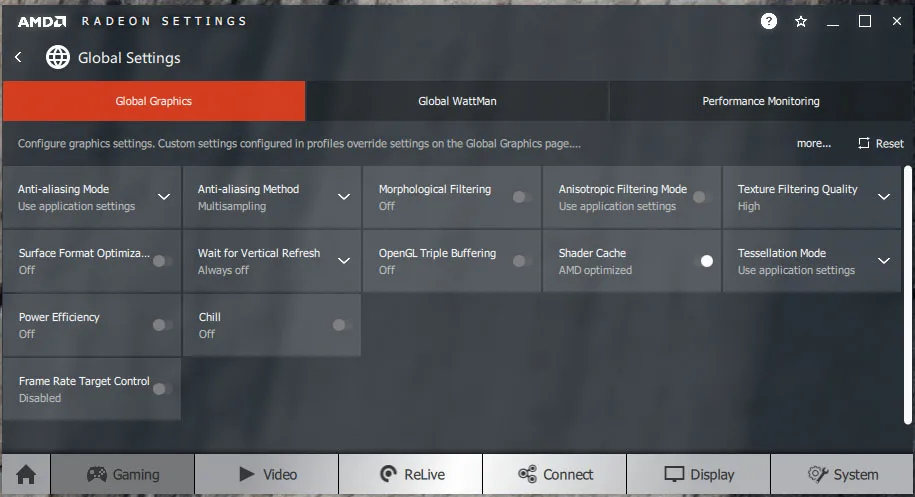 All AMD settings are set so as to be apples-to-apples when compared to NVIDIA’s control panel settings – all optimizations are off, Vsync is forced off, Texture filtering is set to High, and Tessellation uses application settings.
All AMD settings are set so as to be apples-to-apples when compared to NVIDIA’s control panel settings – all optimizations are off, Vsync is forced off, Texture filtering is set to High, and Tessellation uses application settings.
We used WattMan to set the Vega and Polaris cards power, temperature and fan settings but it caused instability with the RX 5700 XT so we used MSI’s Afterburner to increase the fan speed to 40% to eliminate much of its thermal throttling. We spent over 8 hours attempting to optimize our RX 5700 XT’s performance including undervolting, but any use of WattMan caused artifacting, crashes, and system lockups. We are looking forward to the next driver after 19.7.1 and we hope it brings stability.
NVIDIA Control Panel settings
Here are the NVIDIA Control Panel settings that match AMD’s settings.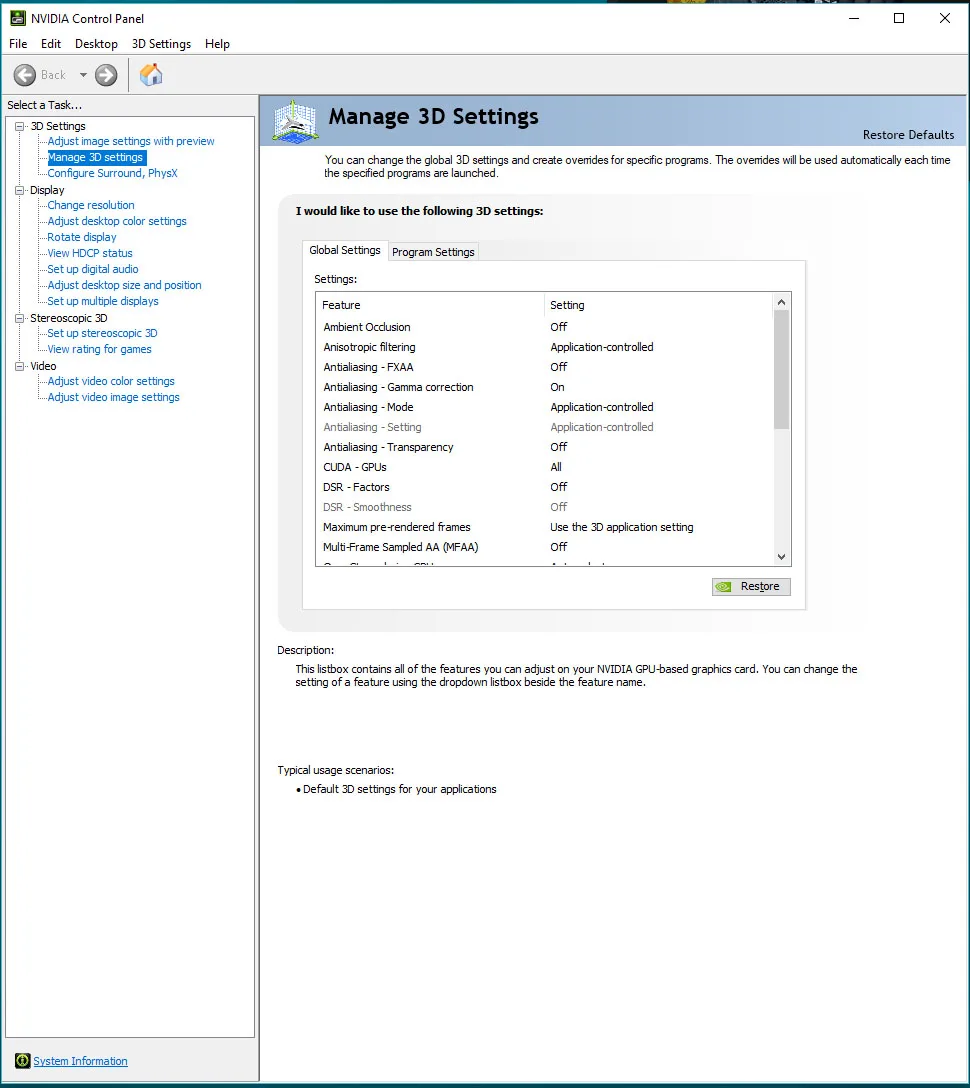
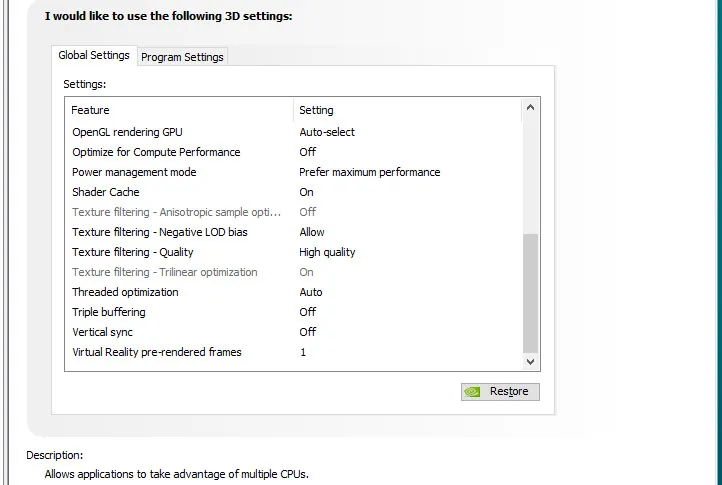 We used Afterburner to set all GeForce’s highest Power and Temperature targets to maximum. By setting the Power Limits and Temperature limits to maximum, they not throttle, but it can reach and maintain its individual maximum clocks. This is particularly beneficial for almost all higher power cards.
We used Afterburner to set all GeForce’s highest Power and Temperature targets to maximum. By setting the Power Limits and Temperature limits to maximum, they not throttle, but it can reach and maintain its individual maximum clocks. This is particularly beneficial for almost all higher power cards.
Let’s check out our RX 5700 XT Anniversary Edition’s clocks, temperatures, and noise
Temperatures, Overclocking, Noise, and Bugs
WattMan caused instability that was also noted by multiple posters on Reddit’s r/AMD. Eventually, we had to do a clean driver install and did not open WattMan to maintain stability. We used Afterburner to downclock by 75MHz to simulate a reference RX 5700 XT, but we still had to increase the fan speed to 40% to eliminate the thermal throttling that occurred with the stock fan settings.
The RX 5700 XT is quiet for a blower. As it ramps up, it becomes noticeable but it is never intrusive. However, the temperatures rose significantly with the stock fan profile. The fan speed barely rose above 2200rpm, but under load the temperatures quickly hit over 80C and performance dropped as the clocks throttled downward from its usual 1980MHz-2020MHz boost clocks range.
AMD advertises the Anniversary Edition’s boost clocks as up to 1980MHz and the reference RX 5700 XT’s as up to 1905MHz, so our card boosts above their specification. Below we see WattMan with the out of the box settings under gaming load.
By setting the fan profile to reach around 40% at 80C, the GPU tended to throttle much less and maintained a more steady boost speed generally above 2020MHz with temperatures only up to 75C.
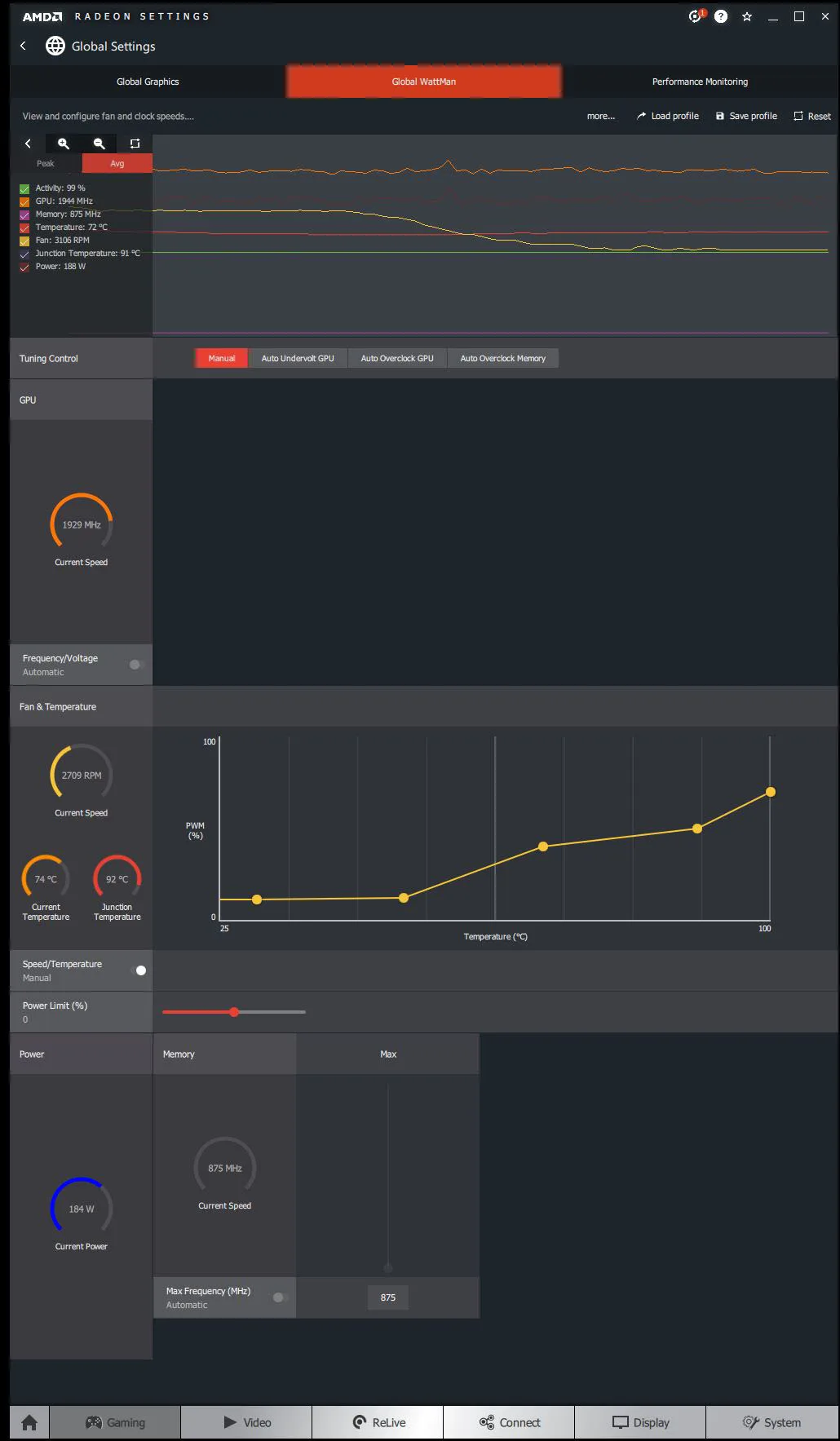 By setting the fan speed to about 40%, it becomes more noisy, but it is tolerable and not at all like what is necessary to endure cooling a reference RX Vega 64, for example.
By setting the fan speed to about 40%, it becomes more noisy, but it is tolerable and not at all like what is necessary to endure cooling a reference RX Vega 64, for example.
Overclocking the RX 5700 XT Anniversary Edition was problematic for us as WattMan caused instability whenever we adjusted any of its settings. By using Afterburner to lower the clockspeeds to reference, we saw that 75MHz makes a difference to performance and it is likely that the GPU will potentially gain performance from further overclocking.
We expect that AMD’s partners will have much more robust cooling available, and we will revisit RX 5700 XT overclocking then. The reference cooler is decent for stock XT clocks, but you probably won’t want to overclock without first increasing the fan speed. The RX 5700 XT runs cool and quiet at stock settings, but it loses performance to thermal throttling as it too easily reaches 80C with its blower cooling.
Besides WattMan’s instability issues, we had noticeable issues with four games – Strange Brigade, Anno 1800, Middle Earth: Shadow of War, and Monster Hunter: World. In each game, playing at 2560×1440, we experienced hitching and stuttering and even crashes to desktop.
Performance summary charts & graphs
Here are the performance results of 40 games and 3 synthetic tests comparing the Anniversary Edition and the simulated reference RX 5700 XT with the liquid-cooled RX Vega 64, the RTX 2060 SUPER and the RTX 2070 SUPER Founders Editions. The highest settings are always chosen and the settings are listed on the charts. The benches were run at 1920×1080 and at 2560×1440.
Most gaming results show average framerates in bold text, and higher is better. Minimum framerates are next to the averages in italics and in a slightly smaller font. The games benched with OCAT show average framerates but the .1 minimums are expressed by frametimes in ms where lower numbers are better.
The first column is devoted to the liquid-cooled RX Vega 64. The second column represents the RTX 2060 SUPER, the third shows the stock RX 5700 XT, the fourth is the Anniversary Edition, while the fifth column represents the RTX 2070 SUPER. As always, open each chart in a separate tab for the best viewing.
We see the $399 RX 5700 XT easily beat the premium liquid-cooled Vega 64 and it also tops the $399 RTX 2060 SUPER while falling a bit short of the $449 75MHz overclocked Anniversary Edition. The $499 RTX 2070 SUPER is the fastest of these cards, but in several games the RX 5700 XT Anniversary Edition is either faster or else comes close in performance.
We note a few oddities where the RX 5700 XT falls strangely short in performance, but they can perhaps be attributed to immature drivers on brand new architecture. AMD tends to bring more performance with subsequent driver revisions. We also think that overclocked partner editions with better cooling may bring even more performance than the blower reference version achieves.
The Big Picture
BTR’s Big Picture places the RX 5700 XTs into a larger group with ten other cards where performance generally increases from left to right, from the GTX 1060 to the RTX 2080 Founders Edition.
Conclusion
The RX 5700 XT brings a higher level of performance above the liquid-cooled RX Vega 64 but with much less power draw and less heat. It would be an excellent upgrade from a GTX 1060 or RX 580/590 level of card and very well-suited for Ultra 1440P gaming or high-refresh 1080P gaming. The reference cooler leaves a lot to be desired and we feel that there is a lot of potential left untapped in this Navi chip that AMD’s partners will address with far more robust cooling. 
Along with Navi, AMD brings some nice features like anti-lag and image sharpening. But this launch also came with multiple issues especially with WattMan that tended to spoil the fun. AMD brings a good $399 value with the RX 5700 XT that is faster than the identically-priced RTX 2060 SUPER. The $449 Anniversary Edition of the RX 5700 XT is a little faster than the reference version and it is priced $50 below the RTX 2070 SUPER.
NVIDIA offers hardware accelerated ray tracing that the RX 5700 series doesn’t plus a two game bundle, while gamers who purchase any new Radeon RX 5700 Series graphics cards from participating retailers will receive a three-month access to Xbox Game Pass for PC, allowing them to play Gears 5 in fall 2019, and 100+ other PC games.
RX 5700 XT Pros
- The reference RX 5700 XT brings good features to $399 and it’s faster than the RTX 2060 SUPER at the same price.
- New RDNA architecture brings higher performance per clock and per watt
- New features include anti-lag technology for competitive gamers and image sharpening for everyone
- The RX 5700 XT is a fast card for Ultra 1440P or for high-refresh 1080P gaming and a solid performance improvement over the power-hungry RX Vega series.
RX 5700 XT Cons
-
- No hardware ray tracing.
- Drivers are immature. Using WattMan caused many game lockups, crashes to desktop, and restarts.
We cannot judge the additional value a 50th Anniversary Special Edition brings which costs $50 more over the reference XT. The GPU is probably better binned and it clocks 75MHz higher which brings a bit more performance, and it offers a custom shroud.
The Verdict:
 7nm hardware and new architecture brings AMD Graphics to a higher playing field. If RDNA proves to be as solid as GCN, it will become the building blocks for the next console generation and several more generations of Radeon PC graphics. Unfortunately, issues with software and a blower-only reference cooler detract from the RX 5700 series launch.
7nm hardware and new architecture brings AMD Graphics to a higher playing field. If RDNA proves to be as solid as GCN, it will become the building blocks for the next console generation and several more generations of Radeon PC graphics. Unfortunately, issues with software and a blower-only reference cooler detract from the RX 5700 series launch.- The RX 5700 XT brings major improvement over AMD’s last generation, and there appears be even more potential performance that can be unlocked by the upcoming partner cards. It competes well with better performance than the RTX 2060 SUPER at the same price.
NVIDIA takes Navi seriously and has premptively responded with the introduction of three new Super cards, two-game bundles, and by allowing price cuts on their current non-super line-up. These extra new choices arriving with the RX 5700 series benefit gamers looking for an upgrade.
As we wait for more stable Adrenalin drivers to overclock, we will return to VR benchmarking. We plan to continue our series of the VR Wars: The RTX 5700 XT Anniversary Edition vs. the RTX 2060 SUPER vs. the RTX 2070 SUPER. Please post your comments and suggestions on Disqus below.
Happy Gaming!

